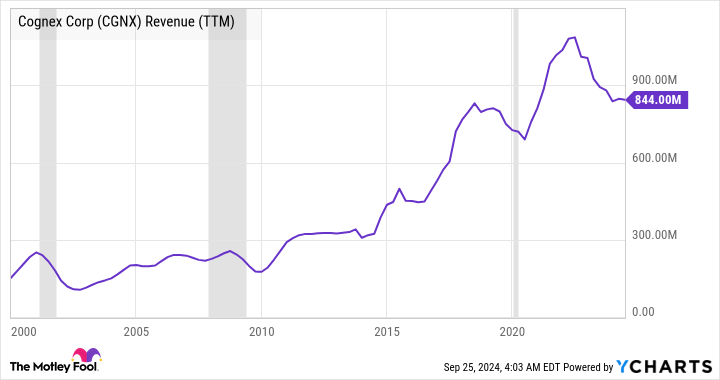2 Top Automation and Robotics Stocks to Buy in October
It's no secret that the industrial economy has been weak, pressured by relatively high interest rates. Still, in such circumstances, it makes sense to invest in industries with a high probability of recovery, and that's why robotics and automation stocks should be high on the buy list. Cognex (NASDAQ: CGNX) and Emerson Electric (NYSE: EMR), are two ways to play this theme.
Two key reasons why these stocks can outperform
First, there are highly favorable long-term secular trends favoring investment in automation. If manufacturing is going to be reshored from low-labor-cost countries, then productivity and quality-enhancing technologies like automation are necessary. Ongoing advancements in the so-called fourth industrial revolution strengthen that argument. These technologies emphasize using artificial intelligence (AI), the Internet of Things (IoT), and advanced analytics to improve real-time operations.

Second, the downturn in the automation market has been exacerbated by a highly unusual set of conditions. Following the lockdowns, many automation companies came up against supply chain and product availability issues that lengthened the time it took to deliver products. In response, distributors built inventory to meet the demand surge after the lockdowns.
With the economy slowing over the last year or so, the distributor focus has been on lowering inventory rather than placing new orders, particularly in factory automation.
Cognex Corporation and machine vision
These two factors are apparent in machine vision company Cognex. Two of its three key end markets, consumer electronics and automotive, have suffered due to relatively high interest rates, and the third, logistics (mainly e-commerce warehousing), is only starting to recover after a deep slump.
The weakness in consumer electronics (Apple is traditionally a major customer) and automotives is understandable as customers hold off investing in production lines in favor of waiting until demand picks up. Cognex typically reserves orders for machine vision solutions on production lines as customers invest in ramping up production or new products.
Lower interest rates will help, and it's only a matter of time before Cognex returns to its long-term trend line.
It's a marketplace that Cognex's management sees growing at a 13% annual rate over the long term, with Cognex growing at a 15% annual rate. Over the long term, machine vision adoption rates will increase as manufacturers use it to capture data and create real-time actionable insights to improve productivity, quality control, and automation.
Emerson Electric and automation
Automation company Emerson Electric is more focused on process automation (processing liquids and materials, such as in the oil and gas, mining, and chemicals industries) than, say, its peer, Rockwell Automation. Emerson Electric generates just 34% of revenue from discrete or factory automation (automotive, semiconductors, e-commerce warehousing) and hybrid automation (food and beverage, life sciences, etc.)
That's one reason it trades at a discount to Rockwell Automation -- process automation is traditionally seen as lower-growth than discrete automation.
Company | EV/EBITDA 2024 | EV/FCF 2024 | EV/EBITDA 2025 | EV/FCF 2025 |
|---|---|---|---|---|
Rockwell Automation | 19x | 48.9x | 16.8x | 24.4x |
Emerson Electric | 14x | 23.4x | 12.8x | 18.4x |
Data source: marketscreener.com. EV = enterprise value (market cap plus net debt). EBITDA = earnings before interest, taxation, depreciation, and amortization. FCF = free cash flow.
However, that discount may not be justified given the company's recent pivot toward automation. Emerson Electric has divested its climate control business and acquired automated test and measurement company NI for an equity value of $8.2 billion. In addition, it owns 55% of industrial software company AspenTech following a deal to contribute some of its existing software businesses in 2022.
The portfolio restructuring has increased Emerson's exposure to automation, and its core process automation market has exciting growth drivers, including LNG, renewables, hydrogen, nuclear, clean fuels, carbon capture, and other technologies critical for the clean energy transition.
All told the combination of its industrial software, discrete/hybrid/process automation exposure, and growth in adjacent markets is a compelling proposition for a stock trading at less than 18 times expected 2025 earnings.
Stocks to buy?
Lower interest rates should help Cognex's and Emerson's discrete automation sales recover in 2025. In addition, distributors should have worked through inventory by then.
The combination should lead to Cognex returning to something close to its long-term expected growth rate of 15% and Emerson returning to the kind of 4% to 7% revenue growth and double-digit earnings growth that management expects for the company.
Should you invest $1,000 in Emerson Electric right now?
Before you buy stock in Emerson Electric, consider this:
The Motley Fool Stock Advisor analyst team just identified what they believe are the 10 best stocks for investors to buy now… and Emerson Electric wasn’t one of them. The 10 stocks that made the cut could produce monster returns in the coming years.
Consider when Nvidia made this list on April 15, 2005... if you invested $1,000 at the time of our recommendation, you’d have $743,952!*
Stock Advisor provides investors with an easy-to-follow blueprint for success, including guidance on building a portfolio, regular updates from analysts, and two new stock picks each month. The Stock Advisor service has more than quadrupled the return of S&P 500 since 2002*.
*Stock Advisor returns as of September 23, 2024
Lee Samaha has no position in any of the stocks mentioned. The Motley Fool has positions in and recommends Apple, Cognex, and Emerson Electric. The Motley Fool has a disclosure policy.
2 Top Automation and Robotics Stocks to Buy in October was originally published by The Motley Fool
